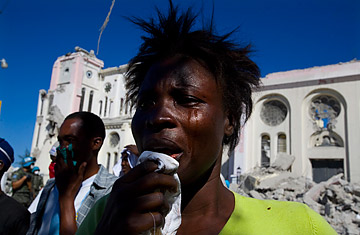
A woman watches bodies being bulldozed from the streets by the U.N. in Port-au-Prince on Jan. 16, 2010
The day after a 7.0-magnitude earthquake struck Haiti, Christian televangelist Pat Robertson sparked outrage with his comments on The 700 Club that the nation's history of catastrophes owed to a "pact with the devil" that its residents had made some 200 years ago. How else to explain why Haiti suffers, while the Dominican Republic — which shares the 30,000 sq. mi. of the Caribbean island of Hispaniola — is relatively well-off? "That island of Hispaniola is one island," Robertson said. "The Dominican Republic is prosperous, healthy, full of resorts, et cetera. Haiti is in desperate poverty."
Robertson's rationale is more than suspect, yet the differences between the two nations are undeniable. The U.N. ranks the Dominican Republic 90th out of 182 countries on its human-development index, which combines a variety of welfare measurements; Haiti comes in at 149th. In the Dominican Republic, average life expectancy is nearly 74 years. In Haiti, it's 61. You're substantially more likely to be able to read and write if you live in the eastern two-thirds of Hispaniola, and less likely to live on less than $1.25 a day.
Much of this difference is geographic. The mountains that lie across the island can cut off Haiti's rainfall. The northeast trade winds, and so the rain, blow in the Dominican Republic's favor. Haiti's semiarid climate makes cultivation more challenging. Deforestation — a major problem in Haiti, but not in its neighbor — has only exacerbated the problem. Other differences are a result of Hispaniola's long and often violent history — even TIME called it a "forlorn, hate-filled little Caribbean island" in 1965. On the eastern part of Hispaniola, you'll probably speak Spanish; in the west, it's more likely to be French or Creole, a division that's the result of centuries of European colonization and numerous power struggles. (Not to mention the decimation of Hispaniola's indigenous Taino people — who, of course, spoke none of those languages.)
When Christopher Columbus arrived in 1492, he named the land La Isla Española. It served as a Spanish colony and base for the empire's further conquests, though it was never particularly profitable. In 1697 the Spanish formally ceded the western third of the island to the French, who were already present and more heavily invested. The Hispaniolan outposts of both empires imported African slaves, though the latter did so to a much greater extent. The colonies — Santo Domingo and Saint-Domingue, respectively — subsequently developed vastly different demographics. According to a study by the American Library of Congress, by the end of the 18th century, there were about 40,000 white landowners, 25,000 black or interracial freedmen and 60,000 slaves in the Spanish colony, compared with approximately 30,000 whites, 27,000 freedmen, and at least 500,000 black slaves in its French counterpart.
As revolution raged in France in the 1790s, its colonial slaves in Hispaniola revolted; in 1804, they declared independence, and Haiti, which was named after the Taino word for "land of mountains," became the world's first sovereign black republic. The Dominican Republic wasn't established until 1844, after not just European rule but also 22 years of Haitian occupation. Strife between (as well as within) the neighbors, rooted in deep class, racial and cultural differences, was constant. Interference by foreign powers was often the norm. The Spanish took back the Dominican Republic in the early 1860s, and for periods during the 20th century, the U.S. occupied both nations, supposedly to restore order but also, in the face of European threats, to assert its influence in the western hemisphere. Internal politics were characterized by multiple coups, revolts and dictators, the most infamous being Rafael Trujillo in the Dominican Republic and François and Jean-Claude Duvalier in Haiti. Juan Bosch, the first democratically elected President of the Dominican Republic in 1962, was almost immediately overthrown after taking office in 1963. Jean-Bertrand Aristide became the first freely elected President of Haiti, in 1990; he was ousted as well, returned and was ousted again.
But while both countries struggled with democracy, economically they began to diverge. Haiti had long been exploited, by foreign powers, neighbors and its own rulers. France not only milked Haiti for coffee and sugar production but also extracted an indemnity from it: the young nation had to pay a burdensome sum to its former colonizer in order to achieve France's diplomatic recognition. The lighter-skinned Dominicans looked down on the darker-skinned Haitians: in 1965, even as the Dominican Republic was embroiled in civil war, Haitians were working in Dominican fields and not the other way around. And while Trujillo at least encouraged economic development in his country, Duvalier père et fils essentially sold their people as cheap sugar-cane cutters to the Dominican Republic.
Today, with a lack of resources and a much higher population density than its neighbor, Haiti is the poorest country in the western hemisphere. The U.N. has sent peacekeeping missions to maintain order there since the mid-1990s, but terrible conditions persist. Haiti's dismal statistics have a long history; no devil is necessary.
